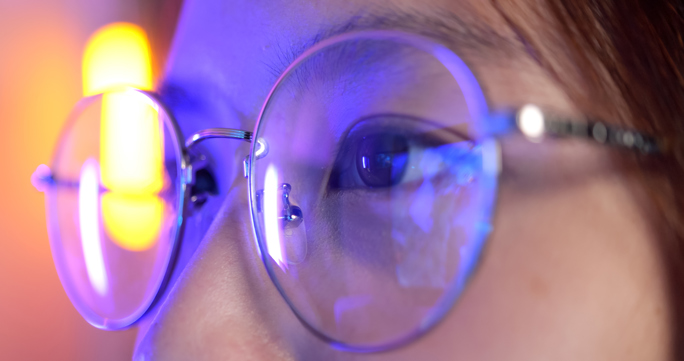Your Guide to Eye Strain
What is Eye Strain?
Most people have experienced eye strain and for many, it occurs regularly as a result of their daily activities. Eye strain is not an eye condition, but a symptom of overworked eye muscles and may also be a sign of vision loss.
For the most part, eye strain is a result of a common daily task like reading, using a computer or phone, or even driving. It is usually not a cause for concern, but it can lead to a series of frustrating and uncomfortable symptoms that make daily life difficult. In this article, we will show you the best ways to prevent and treat eye strain, and how to know when it might be a sign of vision loss or an eye condition.

Eye strain from using screens for extended periods is extremely common and is usually referred to as digital eye strain or computer vision syndrome. As many people use computers and phones for several hours a day and as an essential part of their work and home life, it is especially important to know how to minimise digital eye strain and treat it effectively.
Causes of Eye Strain
The eyes use a series of muscles to focus and like any other muscles in the body, they can become tired and tense. So, when you engage in tasks that require long periods of focusing you may experience eye strain. Common causes include:
- Reading for long periods without taking a break. Small text, reading in poor light or holding your reading material too close can all contribute to eye strain.
- Using a digital device like a computer or phone for several hours a day. The blue light given off by digital screens can be harmful to the eyes and can cause digital eye strain. As with reading, using a screen for an extended period without a break or being too close to the screen can exacerbate the problem.
- Activities that require extended periods of focusing. One common cause of eye strain is driving, which requires focusing on the road for long stretches without taking a break.
- Some vision problems like myopia and hyperopia make it difficult to focus. When these conditions are not managed or treated correctly, they can also lead to eye strain.
The causes of eye strain are for many of us an unavoidable part of our daily lives, whether it be a long commute to work or an office job that requires spending hours in front of a computer. Fortunately, there are ways to prevent and treat eye strain, which will be outlined below.

Occasionally, eye strain is the result of an eye condition or visual impairment like myopia, hyperopia or astigmatism. In these cases, the eyes are having to work hard to cope with vision loss. If you experience eye strain together with frequently blurred vision at near and far distances or problems with your vision in general it may be time to book a comprehensive eye exam with your optometrist.
Symptoms of Eye Strain
People experience eye strain differently and there are a wide range of symptoms, some of which are more common with digital eye strain. The most common symptoms of eye strain are:
- Soreness, itchiness or aching of the eyes. This is perhaps the most common symptom of eye strain, with most people experiencing some kind of pain or discomfort in and around their eyes.
- Dry, red or watery eyes. Strain can affect the way the eyes stay moist, causing them to become irritated which may lead to dryness, redness or tearing.
- Blurry vision or seeing double. Eye strain can be caused in part by reduced blinking. When we blink less the ‘tear layer’ over the surface of our eyes may become irregular leading to these distortions in our vision. (Akpek, n.d)
- Neck, shoulder and back pain. Sometimes when you focus on a task you will unconsciously tense different parts of your body. In this way, a tense posture can contribute to eye strain, which is why it is often accompanied by stiffness or pain in the neck, shoulders and back.
- Sensitivity to light. This includes light from screens, electric light and natural light. Excessive exposure to light, especially the blue light given off by screens, can also cause eye strain.
- Specifically, people will often experience tension headaches focused around the temples or forehead.
- Eye Twitching. In some cases, eye strain can contribute to an eye twitch or spasm.
Digital Eye Strain in Children
Today, digital devices are a part of children's education, entertainment and social lives. They face a unique set of challenges when it comes to using these technologies in a way that protects their eye health and well-being.
Digital eye strain caused by extended screen time can arise from long hours playing video games or watching television, but also from studying or attending classes online. One study looked at how children engaged in online learning were affected — research showed that when they spent more than 4 hours using a computer they began to experience symptoms that included eye strain, headaches, eye dryness and blurred vision (Kozeis, 2009). Taking regular breaks, spending time outdoors and limiting screen time where possible can help to reduce digital eye strain for children. If your child is regularly experiencing eye strain, especially when combined with other vision problems, it is a good idea to have their eyes examined by a qualified optometrist. In the next section, you can read about more ways to prevent and treat digital eye strain for adults and children.

Digital eye strain and its associated symptoms can pose significant challenges for school-age children. The fatigue, discomfort and vision problems caused by eye strain can lead to difficulties concentrating, limit reading comprehension and affect academic confidence. As a parent, looking out for signs of digital eye strain like eye rubbing and difficulties reading or concentrating on tasks can help you to take preventative action when needed.
Treatments and Prevention
Eye strain is a temporary condition usually caused by certain activities and tasks. Usually, the best way to treat it is through taking regular breaks from the activities or environment that brings it on. If eye strain is being brought on or exacerbated by another condition, then it is important to ensure it is being corrected or treated properly and that your prescription is up to date.
Eye drops or ‘artificial tears’ are also an available option that some people find give them relief from eye strain – they work by keeping the eye moist to avoid irritation. However, eye strain will usually have a root cause, which is important to address if you want to limit it in the long run.
Learning how to prevent eye strain is perhaps the best way to limit its effects on your daily life. Here are some preventive methods you can use to reduce eye strain:
- If you work at a computer for several hours a day, read for long periods or regularly use digital devices make sure you take regular breaks from these activities. One good practice is following the 20 - 20 - 20 rule. Every 20 minutes look at something 20 feet away for 20 seconds. The exact distance isn’t too important, but following this general principle can help to reduce digital eye strain.
- Blinking regularly to keep your eyes moist is also a good way to reduce irritation.
- Adjusting the settings on devices to reduce the brightness or blue light is another simple way to reduce eye strain. Most computers, tablets and mobile have this option and it can make a big difference in reducing strain.
- Changing the lighting in your office or at home can also make a big difference. If you are reading or doing anything that requires consistent focusing, ensuring you have adequate light with minimal glare can help to keep your eyes rested.
- Adjusting your distance from your computer or the angle of the screen may also be helpful.
- If you have an existing vision problem, it is important to ensure you have the correct prescription and eyewear. Glasses with specialised lenses are now available that help to reduce glare and blue light, which may help to reduce digital eye strain.
Eye strain varies from case to case, so finding what brings it on for you can help to prevent it. Nevertheless, following the advice above can help to limit the amount of work your eyes have to do and minimise strain and discomfort.
Conclusion
Today, eye strain and digital eye strain are extremely common problems. With so much time spent using screens, it is more important than ever to look out for our eyes. While eye strain doesn’t have any permanent effect on vision, through headaches, fatigue and difficulties in concentration it can have a serious effect on our daily lives. Taking simple steps to prevent eye strain and keep your eyes healthy, can make a big difference.
If you are experiencing eye strain or feel you spend more time than you should on screens, try to follow some of the tips and practices above. You may be surprised at how much of a difference it makes.
References
Akpek, E. K., (n.d) Eye Strain. Johns Hopkins Medicine.https://www.hopkinsmedicine.org/health/conditions-and-diseases/eyestrain
Kozeis, N. (2009). Impact of computer use on children's vision. Hippokratia, 13(4), 230–231. https://www.ncbi.nlm.nih.gov/pmc/articles/PMC2776336/
Related articles





